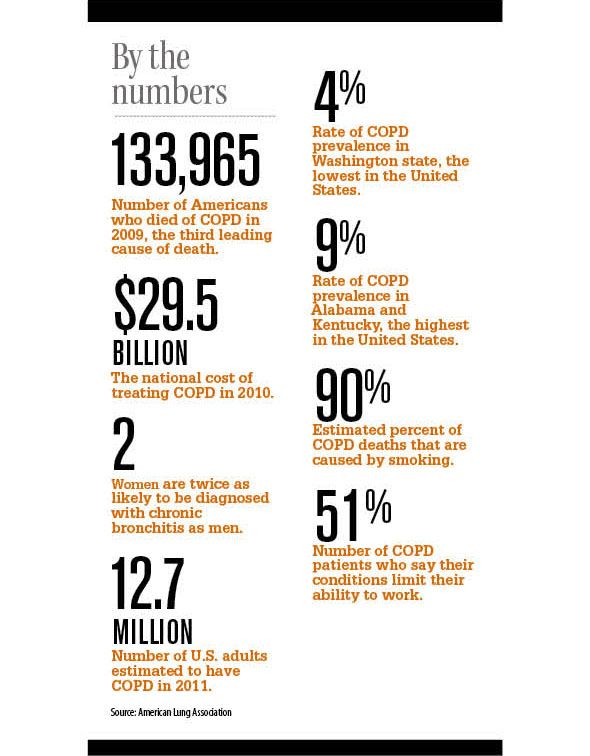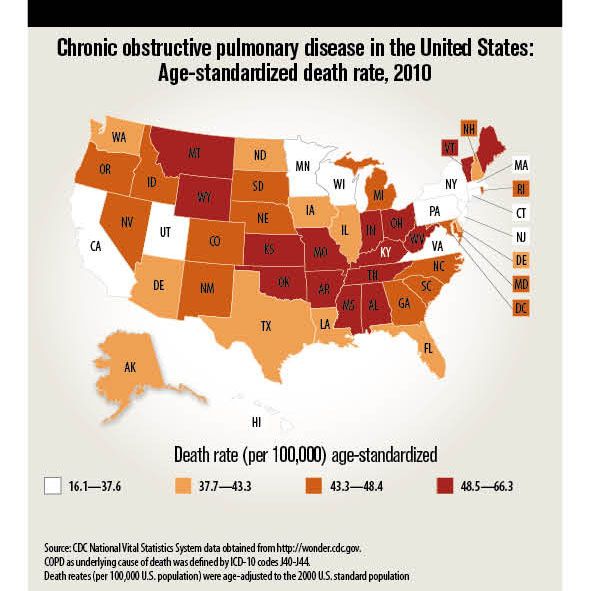Article
Using chronic care methods to treat smoking cessation COPD
Author(s):
Why taking a chronic care approach to smoking cessation is an effective way to battle the third leading cause of death in the United States
When conveying the severity of nicotine addiction, Elyse Carroll likes to tell the story of a former patient who, five days after coming off a ventilator and nearly dying, snuck outside the hospital doors, found a cigarette butt on the ground, lit it up, and smoked it. It takes 4 seconds for nicotine to enter the bloodstream, and the negative health outcomes can be life long.
And while the challenges for patients in conquering the behavioral and physical addiction of smoking have been well documented, so too has its link to the third leading cause of death in the United States--chronic obstructive pulmonary disease (COPD). According to the COPD Foundation, the vast majority (90%) of people with COPD have smoked. COPD most often occurs in people 40 years of age and older who have a history of smoking.
The National Institutes of Health says approximately 12 million adults in the United States are diagnosed with COPD, and 120,000 die from it each year. An additional 12 million are thought to have the condition but remain undiagnosed. An estimated $37 billion is spent in the U.S. annually treating COPD, which is an umbrella term for lung diseases including emphysema, chronic bronchitis, refractory asthma, and some forms of bronchiectasis.
Exacerbating the issue, says Carroll, a respiratory disease manager at Hospital for Special Care in New Britain, Connecticut, is the fact that the presence of COPD can actually make it harder to quit smoking.
“Just think about when you have COPD and you can’t breathe,” Carroll explained. “When you can’t breathe, that causes you anxiety and stress. What’s a trigger to smoke? Anxiety and stress. One of the symptoms of their chronic disease is one of their triggers.”
Because of its cost to society and the healthcare system overall, COPD is increasingly included in payer pay-for-performance programs that reward physicians for improved outcomes. Because of the association between smoking and COPD, efforts to reduce COPD rates and improve outcomes for those already diagnosed must include smoking cessation programs. And researchers have found that treating smoking like a chronic disease is the most effective way to confront tobacco dependence and reduce the risks of COPD.
Benefits of a chronic disease approach
The process of successfully quitting smoking is not dissimilar when compared with managing a chronic disease. In fact, the U.S. Public Health Service designated tobacco dependence a chronic condition in 2000 because it often requires repeated intervention and multiple attempts to quit successfully.

“Tobacco dependence disorder is a chronic relapsing condition, yet treatment is delivered in discrete episodes of care that yield disappointing long-term quit rates,” wrote Anne Joseph, MD, MPH, professor of medicine at the University of Minnesota School of Medicine, coauthor of a 2011 study published in JAMA Internal Medicine that looked at chronic disease management for tobacco dependence.
Joseph’s research found that a chronic disease approach-targeting the goal of quitting smoking but incorporating failures, setting interim goals, and continuing care until the desired outcome is achieved-is approximately 75% more effective than short-term, discrete approaches.
Someone trying to quit smoking typically goes through relapses, much like chronic disease sufferers, according to Joseph. Instead of treating those relapses as the end of the journey to quit, physicians can help patients figure out the reasons for the relapses and ways they can address them, she says. And if they cannot completely quit, there are benefits to reducing the amount they smoke, she adds.
When patients relapse, they feel like they failed, says Xavier Soler, MD, PhD, a member of the COPD Foundation Educational Review Working Group and an assistant professor of medicine in the division of pulmonary and critical care at the University of California San Diego. It’s up to physicians to show some compassion, he says.
If someone comes to a doctor with a condition such as hypertension or diabetes, they are placed on medications, a diet, and/or an exercise regimen. If their condition isn’t controlled by the prescribed regimen, physicians don’t consider them a lost cause, says Soler.
“You are going to say: ‘Let’s review why you went off the diet, or whatever the reason … and figure out what was not working,’ ” he says. The same approach should be taken with smoking cessation.
Implementing a chronic smoking cessation program
There are many methods that can be used in smoking cessation, says Richard Novitch, MD, director of pulmonary rehabilitation, and the pulmonary function/blood Gas Laboratory at Burke Rehabilitation Hospital in White Plains, New York. Studies have found nicotine replacement therapy (NRT) can increase the likelihood of success for patients attempting to quit smoking. Novitch says some patients need only NRT, while others need to combine NRT with medications such as Bupropion Hcl or varenicline.
The first step practices can take is to treat smoking status as a vital sign, Joseph says. Just like blood pressure and temperature are recorded for every patient, at every visit, so should smoking status. If they identify as a smoker, the next question should be whether they want to quit. Asking at every visit will also help physicians identify those who relapsed.

The Affordable Care Act provided for the expansion of smoking cessation programs by requiring marketplace plans to cover them. For physicians, this means some smoking cessation treatments, including in-office counseling, will be reimbursed. However, there is a wide variation in the types of treatments that are covered and whether there is coverage for medications or NRTs.
Carroll says many plans allow physicians to bill for a 3- to 10-minute session or a session of more than 10 minutes. Many cover up to four sessions, twice a year.
The first one to three months of a smoking cessation program is when the physical part of the addiction is addressed, says Carroll. This is when withdrawal symptoms are treated, usually with NRT and/or medication.
An open dialogue with patients during these first few months will help physicians know what course to take and if it needs to be modified. For example, Novitch has often seen first quit attempts fail because of under-prescribing of NRT.
After the physical addiction is addressed, the treatment moves toward the psychological and social issues. Identifying triggers and celebrating milestones are very important during this phase. Carroll says patients who make it through a year have the best chances for long-term success.
Joseph says that once a patient has expressed an interest in quitting, it remains on the table until they have succeeded, no matter how many failed attempts. Physicians should continue working with them and make modifications as needed, which may include the goals themselves. Some patients may need to focus on cigarette reduction instead of quitting entirely. Joseph compares it to patients who fall off of a diet.
“This doesn’t mean you now go out and binge eat,” Joseph says.
The investment and reward
Implementing a chronic smoking cessation program will require buy-in from everyone on the staff of a medical practice, says Paul Scalise, MD, senior vice president of medical affairs and chief of staff at the Hospital for Special Care.
Often, the physician has only 15 minutes to see a patient so he or she can’t be the only one on staff committed to this, says Scalise. Medical technicians can start the discussion when they bring the patient in, he says. The same applies to the nurse, when taking the patient’s vital signs.
Practices may consider hiring someone to facilitate counseling sessions or to conduct follow-up phone calls and outreach. Existing staff members can also be trained as smoking cessation counselors, Joseph says.
There are also community-based resources to which physicians can refer patients. There are 1-800 quit lines in every state, says Novitch. In addition to counseling and support, many provide NRT starter kits free of charge. Also, local hospitals often host support groups that are free to patients. But, warns Joseph: “You can outsource so much that you lose the benefit.”

Physicians may check a box saying he or she referred the patient to a 1-800 number, but fail to do any follow-up, Joseph says. Some patients might prefer getting treatment from a provider with whom they have a relationship. They may feel too distanced from their healthcare provider going to a program outside the practice.
There’s benefit to proactive outreach, as well. “There’s good data to support the fact that there are people who are interested in quitting who don’t access services,” says Joseph.
Most electronic health record systems allow smoking status to be recorded as discrete data. Using this data, population-based reports can be generated that list every patient who identified as a smoker. Joseph says she uses these reports to reach out to the identified smokers to see if they want help quitting and to inform them of existing programs.
Because so many COPD cases can be linked to smoking, “To ignore smoking is to ignore the fact that [COPD] even exists,” says Scalise.
After a patient has been diagnosed with COPD, his or her conditions are made worse if they continue to smoke, says Soler. Studies have shown those who quit live longer. This is increasingly important as physician payment models shift toward outcomes-based compensation.
Reducing the number of smokers won’t mean physicians are less busy though, says Stephen Karbowitz, MD, director of the division of pulmonary medicine at New York Hospital Queens. Reducing the number of middle-age COPD patients will allow physicians more time to treat the older, sicker population, he says. Reducing the number of smokers “wouldn’t necessarily reduce costs, but would help to keep them from rising.”
Novitch disagrees. He says savings could be realized almost immediately. One major source of savings would be the reduced visits to the emergency department, he says.
“Smoking cessations is one of the most positive things we can do for patients’ health … and maybe our bottom lines,” says Novitch.





